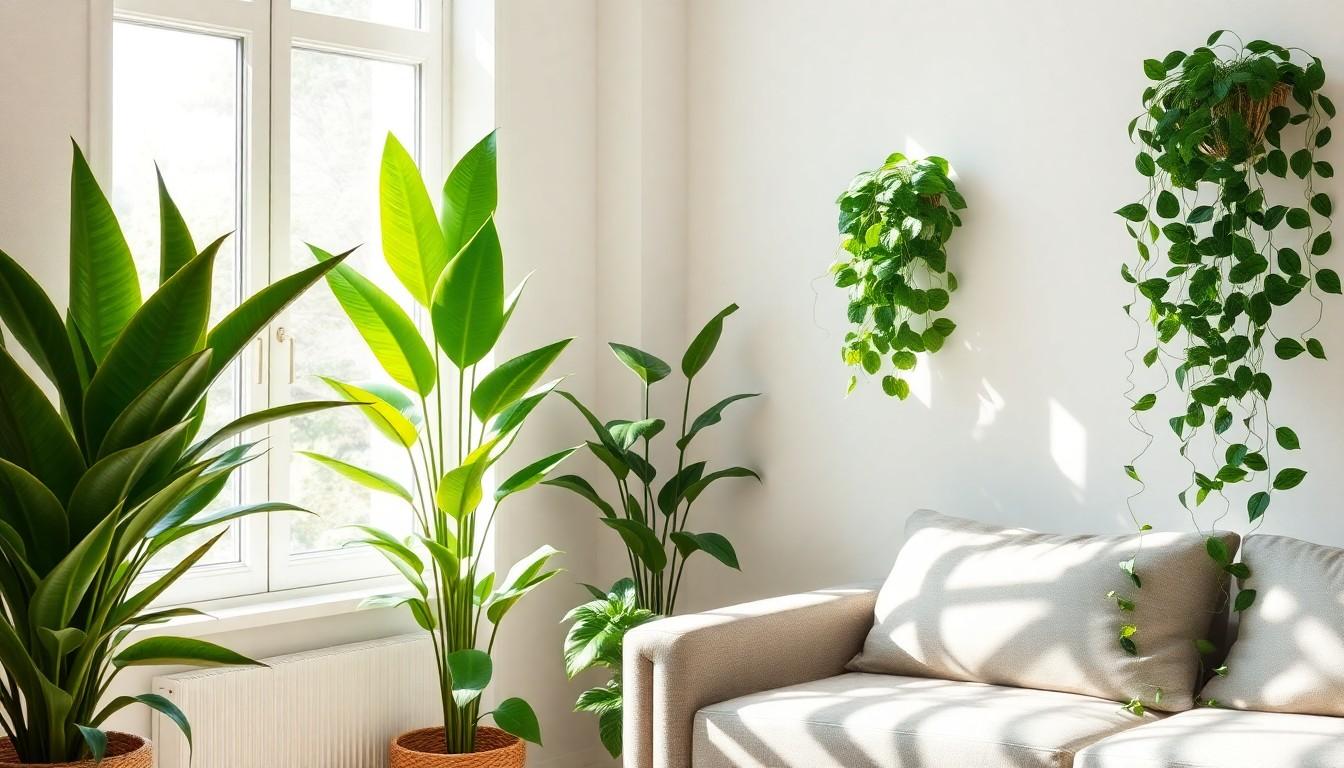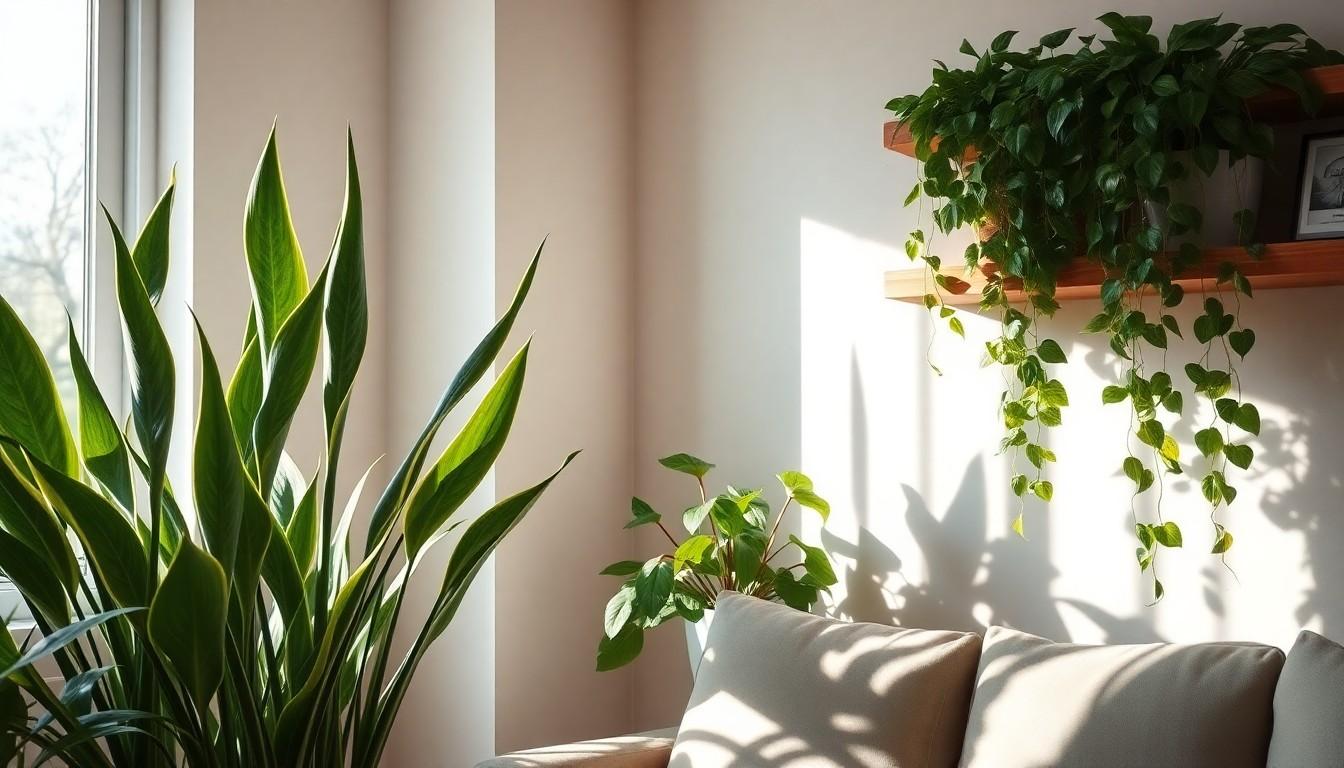Imagine transforming your home into a lush oasis without needing a sun-soaked greenhouse. Large house plants that thrive in low light are the unsung heroes of indoor gardening. They’re like the cool kids at the party—easygoing and adaptable, they don’t mind skipping the spotlight while still making a statement.
These leafy giants not only purify the air but also bring life to even the dreariest corners of your home. Whether you’re a plant novice or a seasoned pro, these low-light wonders can elevate your space without demanding your attention like a needy housemate. Get ready to discover how these verdant beauties can flourish in the shadows and turn your home into a green sanctuary.
Benefits Of Large House Plants In Low Light
Large house plants in low light provide numerous advantages that enhance indoor environments. These plants thrive in dim conditions, offering remarkable benefits.
Improved Air Quality
Large house plants significantly improve air quality. They absorb harmful toxins like formaldehyde and benzene, contributing to a healthier living space. Studies show that indoor plants can lower pollutants, promoting better respiratory health. Through the process of photosynthesis, these plants release oxygen, increasing air freshness. Having multiple species like the Snake Plant or ZZ Plant creates a natural air purifier effect throughout the home.
Enhanced Aesthetic Appeal
Enhanced aesthetic appeal is another key benefit of incorporating large house plants. Bold greenery complements various interior designs, adding dimension and warmth to any room. Large plants serve as focal points, drawing attention and creating an inviting atmosphere. They can transform bland corners into lively spaces, providing a touch of nature indoors. Strategically placing plants like the Rubber Plant or Fiddle Leaf Fig elevates visual interest while promoting relaxation.
Popular Large House Plants For Low Light

Large house plants thrive in low light, bringing a touch of nature indoors. Some popular options include the snake plant, ZZ plant, and pothos.
Snake Plant
Snake plants adapt well to low light conditions. They feature long, upright leaves that can reach heights of 4 feet. This plant requires minimal watering, making it perfect for those who may forget to water regularly. Snake plants also possess air-purifying qualities, absorbing toxins while releasing oxygen. Their striking appearance brings a modern touch to any room.
ZZ Plant
ZZ plants shine in low light environments. Known for their thick, waxy leaves, they can grow 2 to 3 feet tall. Easy to care for, ZZ plants tolerate neglect and infrequent watering. This resilience makes them great options for busy individuals. ZZ plants also enhance indoor air quality, filtering out harmful substances. Their glossy leaves create an elegant aesthetic, making them ideal focal points in any space.
Pothos
Pothos plants thrive in various light conditions, including low light. These trailing vines can grow up to 10 feet long. They require minimal maintenance and can adapt to a range of indoor climates. Pothos plants are excellent for improving air quality and eliminating toxins from the air. Their cascading foliage creates a lush, vibrant atmosphere, perfect for brightening corners or shelves in any home.
Tips For Caring For Large House Plants
Caring for large house plants requires attention to specific needs. Providing optimal conditions, especially in low-light settings, keeps these plants healthy and vibrant.
Watering Guidelines
Watering large house plants requires a careful approach. Checking the top inch of soil can determine if watering is needed. When soil feels dry, water thoroughly until it drains from the bottom. Allow the pot to sit in excess water for no more than 15 minutes to prevent root rot. Consistency is vital, so establish a watering schedule that suits the plant’s requirements.
Fertilization Techniques
Using fertilizer enhances the growth of large house plants. Apply a balanced liquid fertilizer every 4-6 weeks during the growing season, typically spring and summer. Ensuring dilution, as per package instructions, prevents fertilizer burn. Reducing or skipping fertilization in fall and winter caters to the plant’s dormant period, conserving energy and resources.
Pruning and Maintenance
Regular pruning fosters robust growth in large house plants. Trimming dead or yellowing leaves encourages new foliage and prevents disease. Maintaining clean, sharp tools supports healthy cuts, minimizing potential stress. Dust buildup on leaves impacts photosynthesis, so gently wiping leaves with a damp cloth promotes better light absorption. Implementing these maintenance steps enhances overall plant health and longevity.
Common Mistakes To Avoid
Maintaining large house plants in low light requires careful attention. Several common errors can hinder their growth and vitality.
Overwatering
Overwatering ranks as a prevalent mistake. Saturated soil suffocates roots, leading to root rot. Instead of a rigid watering schedule, checking the top inch of soil for dryness helps determine the right moment to water. Allowing soil to dry slightly protects against excess moisture. Signs of overwatering include yellowing leaves and wilting stems. Adjusting watering habits increases the chances of healthy growth.
Insufficient Lighting
Insufficient lighting poses a significant challenge. While low-light plants thrive in dim environments, they still require some light. Placing plants too far from windows significantly limits their ability to photosynthesize. Monitoring their location ensures they receive indirect light throughout the day. During darker months, consider using grow lights to supplement natural light. A lack of proper illumination leads to leggy growth and poor health. Boosting light exposure naturally strengthens plants and promotes lush foliage.
Conclusion
Large house plants that thrive in low light offer an excellent solution for those looking to enhance their indoor spaces. With their ability to purify the air and add vibrant greenery, these plants create a welcoming atmosphere in any home. Their low-maintenance nature makes them perfect for anyone, regardless of gardening experience.
By choosing popular varieties like the snake plant, ZZ plant, and pothos, individuals can easily incorporate these lush additions into their decor. With proper care and attention, these resilient plants will flourish even in dim conditions, transforming dull corners into lively focal points. Embracing large house plants not only beautifies a space but also contributes to a healthier living environment.

